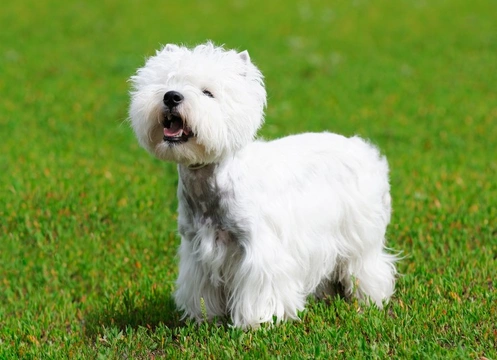Pets
Pets for studWanted petsBreedersAccessories & services
Knowledge hub
Support
Support & safety portal
Craniomandibular Osteopathy in Dogs (CMO)
Craniomandibular osteopathy or CMO for short is a hereditary conformation problem that can affect certain terrier breeds, and which is also sometimes referred to as “lion jaw.” The condition affects the jaw bones-called the mandibles-and sometimes, the joints that attach the jawbones too, as well as potentially affecting the rest of the skull and even the legs in rare cases.
This leads to noticeable changes to the conformation of the dog’s jaw and face, and can also be painful as well as causing problems eating and drinking normally, moving or opening the mouth, and causing excessive drooling. However, the condition tends to disappear or correct itself over time, which means that it is not always possible to identify adult dogs with the condition later in life.
Because craniomandibular osteopathy is a hereditary health condition, it can be passed on from parent dogs to their offspring, but the condition can be prevented by means of health testing and selective breeding to ensure that only healthy dogs are mated.
In this article, we will examine the types of dogs that are at risk of inheriting craniomandibular osteopathy, how to find out the status of any given dog, and what the condition means for dogs, dog owners and breeders. Read on to learn more.
More about craniomandibular osteopathy
Craniomandibular osteopathy is a type of bone disease, which affects dogs while they are still young and their bones and joints are growing and developing. The jaw bone itself is the most acutely affected bone, but other parts of the skull may also display growth anomalies including the joints of the jawbones and the bones in the ear among others, and even in some cases, the long bones of the leg.
Craniomandibular osteopathy causes irregular lesions to develop on both sides of the face of the affected dog, and the condition begins when affected dogs are young and their bones and joints are still growing and developing. Generally, symptoms do not become apparent until pups are 4-8 months old, which means that unless pre-breeding health screening was undertaken on the parent dogs, a puppy buyer may find themselves unwittingly taking on a pup that appears healthy, only to find out within a few months that they are actually affected.
The first symptoms of the condition include swollen jaws, which will affect both sides of the face but not necessarily equally, and which can cause pain opening and closing the mouth or in acute presentations, inability to open the mouth at all.
Problems with eating and drinking normally are common, and the condition can also lead to drooling due to either discomfort or being unable to properly open or close the mouth. Affected dogs will also tend to be miserable and lethargic, and may suffer from other symptoms such as a fever that tends to peak and fall in cycles of a week to a fortnight at a time.
What sort of dogs are at risk?
Craniomandibular osteopathy has been identified as a potential risk for dogs from certain terrier breeds, being the Cairn Terrier, West Highland White Terrier and the Scottish Terrier respectively. Because the potential gene pool of pedigree breeds is limited to only dogs within the breed in question, hereditary health conditions such as craniomandibular osteopathy can spread across an ever-widening number of dogs of the breed due to its comparatively narrow range of genetic diversity.
CMO cannot be caught or otherwise passed on between dogs, and the only way a given dog can develop the condition is to have inherited the genes that cause the condition from their parents.
How is the condition passed from dog to dog?
Craniomandibular osteopathy is passed on from parent dogs to their offspring by means of autosomal dominant heredity with incomplete penetrance. This means that the condition is harder to breed out of breed lines than autosomal recessive conditions, which will not be passed on if only one of the parent dogs is affected by the condition-but not every single pup of an affected dog or bitch will inherit it either, due to the incomplete penetrance.
Dogs that inherit two copies of the faulty or mutated gene that causes the condition have a higher risk of developing CMO, but even dogs that only inherit one copy may also be affected. Some dogs will inherit carrier status for the condition, which means that while they themselves will not be affected, they can still pass it on to their own offspring.
Carrier dogs inherit one copy of the mutated gene, and one normal gene-these dogs will pass on the same mutation to around 50% of their own offspring, while the other 50% will be clear.
Dogs that inherit two copies of the mutated gene have a much higher chance of being affected themselves, although not all dogs that inherit two copies will have problems. However, they can still pass the mutation on through the breed line, even if they themselves appear healthy and unaffected.
Health testing and how it can help breeders and buyers to select healthy dogs
In order to ensure that only healthy dogs are used for breeding, and to allow puppy buyers to make an informed decision about a potential purchase, dogs of the three affected breeds should be tested prior to breeding to identify their status.
This can be achieved by means of DNA testing, using either a blood sample or a buccal swab from the dog, which is sent away to a laboratory, and who will then return a result of the dog’s status.
This helps breeders to make a final decision on any mating match and the health of their subsequent litter, and can reassure buyers of puppies from affected breeds about the health status of their potential purchase.



